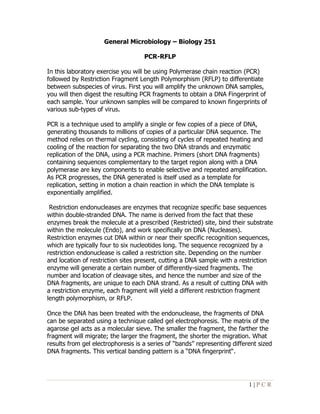
Pcr
- 1. General Microbiology – Biology 251 PCR-RFLP In this laboratory exercise you will be using Polymerase chain reaction (PCR) followed by Restriction Fragment Length Polymorphism (RFLP) to differentiate between subspecies of virus. First you will amplify the unknown DNA samples, you will then digest the resulting PCR fragments to obtain a DNA Fingerprint of each sample. Your unknown samples will be compared to known fingerprints of various sub-types of virus. PCR is a technique used to amplify a single or few copies of a piece of DNA, generating thousands to millions of copies of a particular DNA sequence. The method relies on thermal cycling, consisting of cycles of repeated heating and cooling of the reaction for separating the two DNA strands and enzymatic replication of the DNA, using a PCR machine. Primers (short DNA fragments) containing sequences complementary to the target region along with a DNA polymerase are key components to enable selective and repeated amplification. As PCR progresses, the DNA generated is itself used as a template for replication, setting in motion a chain reaction in which the DNA template is exponentially amplified. Restriction endonucleases are enzymes that recognize specific base sequences within double-stranded DNA. The name is derived from the fact that these enzymes break the molecule at a prescribed (Restricted) site, bind their substrate within the molecule (Endo), and work specifically on DNA (Nucleases). Restriction enzymes cut DNA within or near their specific recognition sequences, which are typically four to six nucleotides long. The sequence recognized by a restriction endonuclease is called a restriction site. Depending on the number and location of restriction sites present, cutting a DNA sample with a restriction enzyme will generate a certain number of differently-sized fragments. The number and location of cleavage sites, and hence the number and size of the DNA fragments, are unique to each DNA strand. As a result of cutting DNA with a restriction enzyme, each fragment will yield a different restriction fragment length polymorphism, or RFLP. Once the DNA has been treated with the endonuclease, the fragments of DNA can be separated using a technique called gel electrophoresis. The matrix of the agarose gel acts as a molecular sieve. The smaller the fragment, the farther the fragment will migrate; the larger the fragment, the shorter the migration. What results from gel electrophoresis is a series of “bands” representing different sized DNA fragments. This vertical banding pattern is a “DNA fingerprint“. 1|PCR
- 2. PCR (Day 1) Materials: 1. Master Mix (MM) a. This contains DNA Polymerase, Primers, Buffers and Water 2. Your test sample of DNA, labeled with a specific number. 3. Thermal Cycler (PCR machine) 4. Pipettes and tips Procedure: 1. Take 20 µl of your Master Mix cocktail and add to each of your two DNA tubes. a. Label this tube; you will be getting it back next lab period. 2. Mix well 3. Take your DNA/Master Mix cocktail tube to the PCR machine. 4. When the IA has all samples they will start the PCR machine. This will take a long time so you will finish next class period. Thermal Cycler settings are as followed: Step Function Temperature Duration Cycles Initial Denature 94◦C 2 min 1 Denaturation Denature 94◦C 1 min PCR Anneal 59◦C 1 min 40 Amplification Extension 72◦C 2 min Final Extend 72◦C 10 min 1 Extension Hold Hold 4◦C Indefinite 1 PCR (Day 2) Materials: Your PCR products Restriction Digest Mix Pst1 restriction enzyme Water Bath Practice plates Practice dye Micropipette with tip box A 1% Agarose TBE gel (for the whole class to share) A tube of loading dye, labeled Dye. Gel electrophoresis chamber (for the whole class to share) 2|PCR
- 3. Procedure: Part I - Restriction Digest: 1. Remove 15 µl of DNA sample and transfer to the Restriction Digest Mix 2. Mix, centrifuge briefly 3. Incubate at 37ºC for at least 30 minutes to one hour. Gel Loading Practice: Practice loading samples into the wells of the practice plates Flood the practice wells in the agar plate with water. Practice loading 10 µl or 20 µl of the practice solution per well using a micropipette. The DNA solution is clear, and we need some way to follow the movement of the DNA through the gel while it is running. The digestion buffer contains a loading/tracking dye that moves through the gel slightly ahead of the smallest DNA fragments. The digestion buffer also contains a heavy substance such as glycerol or sucrose to make the sample sink through the buffer into the wells. Try not to touch or puncture the wells with the pipette tip, if you do the banding pattern on your analytical gel may be messy. Part II - Gel Electrophoresis: 1. Add 2.5 µl of loading dye to the remaining DNA sample in the PCR tube. 2. Mix well 3. Following the guidelines, load both your cut and uncut PCR fragments on to the 1% agarose gel. 4. Run the gel for 30 min at 100 volts. 5. View gel and record your results. 3|PCR